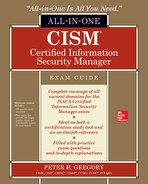Book Description
This effective study guide provides 100% coverage of every topic on the latest version of the CISM exam
Written by an information security executive consultant, experienced author, and university instructor, this highly effective integrated self-study system enables you to take the challenging CISM exam with complete confidence. CISM Certified Information Security Manager All-in-One Exam Guide covers all four exam domains developed by ISACA. You’ll find learning objectives at the beginning of each chapter, exam tips, practice questions, and in-depth explanations. All questions closely match those on the live test in tone, format, and content. “Note,” “Tip,” and “Caution” sections throughout provide real-world insight and call out potentially harmful situations. Beyond fully preparing you for the exam, the book also serves as a valuable on-the-job reference.
Covers all exam domains, including:
•Information security governance
•Information risk management
•Information security program development and management
•Information security incident management
CD ICON
Electronic content includes:
•400 practice exam questions
•Test engine that provides full-length practice exams and customizable quizzes by exam topic
•Secured book PDF
